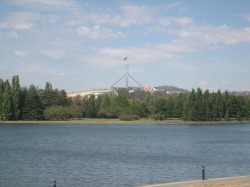|
Location Canberra Equipment Zoom F4 Sennheiser MKH 60 Boom Pole array and R09 handheld Today I had to fly up to Canberra for the day. For those of you who may not know, Canberra is Australia’s capital. Yeah I know, most people thinks its Sydney, which is understandable as a lot of stuff happens in Sydney and the only thing that seems to happen in Canberra is politicians arguing. Canberra was constructed specifically to serve as our capital and as such has been designed and laid out specifically, rather than growing organically as most cities do. It’s a tidy, fairly attractive city but it has a reputation for being a bit dull. It is however home of many of our national institutions and that was why I needed to fly up for the day. I had a meeting with some people at the National Museum of Australia, which is a fairly new building on the edge of a giant lake. I arrived a bit early so I thought I would take a look around. The outside of the main museum building is clad in large sheets of metal, and because of the strength of the sun they had gotten very hot, the result was a constant clicking and popping sound as the metal sheets expanded and contracted in the heat. The overall effect of dozens of these sheets sounded something like a field of insects. I tried to record a fair amount of material, but I am not sure yet how good the samples will be as the individual sounds were fairly quiet. It was a very interesting effect. After the meeting I decided to walk around the lake to the Carillon (pronounced Carillion) which is a large tower with bells in it that plays melodies at certain times of the day. It also chimes much like a town clock on the hour and on the quarter hour. The Carillon in Canberra is a well known location and is often used for performances; its position on the edge of the lake makes it a good spot for tourists. I wanted to get a recording of it while I was in Canberra as it is a significant Australian sound source. When I arrived there were a bunch of guys having a bbq and listening to music right next to the carillon. I asked them if they wouldn’t mind killing the music or a couple of minutes while I did some recording. They were really good about it and even offered me a beer while we waited. I may be wrong here, but this strikes me as such an Australian thing to do. A complete stranger comes along, interrupts your party, asks a favour but you offer him a beer and say cheers to him. Its not that other cultures don’t have great hospitality, but the offer of a beer to someone on a hot day is something Australians seem proud to do, and I have to say that after walking 5 or 6 km around the lake from the museum in 30 degrees that beer tasted bloody marvellous. At 5pm the Carillon sounded its regular chimes. (Sounded like the Westminster clock chime pattern to me) and then it went into a pre programmed pattern of music for about 15 minutes. I captured a few minutes of some of the various pieces it played. It's been nearly 20 years since I was last in Canberra but I’m sure the last time I was there the Carillon sounded much more out of tune, so whether they “fixed” it or whether my ears have adjusted over time, I found the tunes interesting to listen to. I didn’t do much recording today, but I did carry all my gear on the plane simply to capture the Carillon. If I am going to travel somewhere I don’t get to very often I will always take what I can with me just in case I get a chance to record something interesting. There were some nice bird sounds around the lake, but all the roads were far too close to be able to get a good recording of anything, and I just didn’t have the time to go anywhere remote and do more recording. I am more than likely to be travelling to Canberra again fairly soon as I might find myself doing some work with the National Museum, so maybe next time I can plan on recording some bird sounds.
0 Comments
Leave a Reply. |
AuthorStephan Schütze has been recording sounds for over twenty years. This journal logs his thoughts and experiences Categories
All
Archives
April 2019
|


 RSS Feed
RSS Feed
